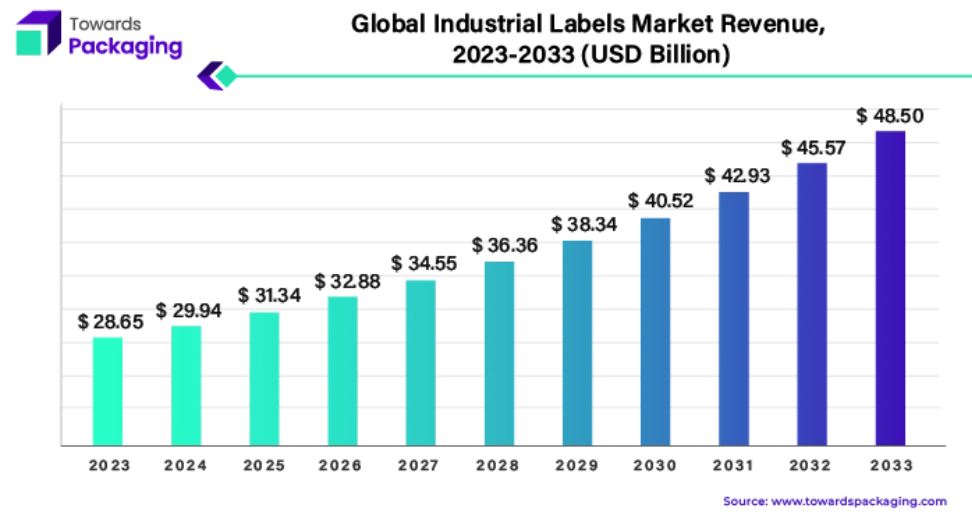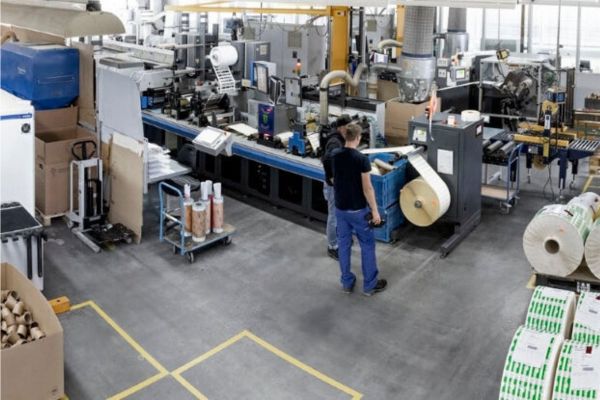The industrial labels market is expected to grow at a considerable CAGR during the forecast period. Industrial labels help in asset tracking, product identification processes of all kinds and ensuring that all the safety regulations is followed. Industrial labels are incredibly durable, ultra-solvent and abrasion resistant.
They are capable of handling temperatures ranging from -292°F (-180°C) to +730°F (+388°C). They are ideal for use in all applications across the automotive, military, aerospace, and oil and gas industries since they are made to withstand tough industrial conditions.
The Increasing Demand for Efficient Identification and Tracking Solutions
Industrial labels are essential for product identification, tracking, and safety. They are used across a wide range of industries including manufacturing, automotive, aerospace, electronics, and logistics. The demand for efficient and reliable labeling solutions has been propelled by the need for enhanced operational efficiency, regulatory compliance, and brand protection.
Technological Advancements in Labeling Solutions
The adoption of advanced technologies such as RFID (Radio-Frequency Identification), QR codes, and barcoding has revolutionized the industrial labels market. These technologies offer superior tracking, traceability, and data management capabilities, making them indispensable in modern industrial applications.

The global industrial labels market is poised for significant growth, with projections indicating a rise from USD 28.65 billion in 2023 to USD 48.50 billion by 2033. This remarkable expansion, occurring at a Compound Annual Growth Rate (CAGR) of 5.51% from 2024 to 2033, underscores the critical role of industrial labels in various sectors. In this comprehensive analysis, we delve into the factors driving this growth, the emerging trends, and the key segments contributing to the market’s development.
Key Trends and Findings in the Industrial Labels Market
The industrial labels market is witnessing dynamic changes driven by technological advancements, consumer demands, and regulatory requirements. Here’s a detailed exploration of the key trends and findings shaping this evolving sector:
Flexible Printed Electronic Designs and Smart Labels
Transition to Commercial Production
Flexible printed electronic designs are advancing from concept to large-scale commercial production. This shift is pivotal as it enables the creation of smart labels with enhanced functionalities. These labels integrate low-power IoT technologies like Bluetooth, LPWAN (Low-Power Wide-Area Network), and cellular technologies. Such advancements are crucial for developing RF labels that offer improved capabilities in tracking, monitoring, and data transmission.
Enhanced User Engagement with QR Codes and AR
Integration into Printed Labels
Two transformative technologies enhancing user engagement are QR codes and augmented reality (AR). QR codes embedded in labels provide instant access to a wealth of information such as websites, user guides, product details, and promotional videos. Users simply scan the QR code with their smartphones to access relevant content, thereby enriching their product experience.
Sustainability and Traceability Initiatives
Driving Market Innovations
The global emphasis on sustainability is prompting organizations to adopt systems and practices that minimize waste and benefit society. In the industrial labels sector, traceability plays a crucial role. It involves tracking goods and materials throughout the supply chain to enhance visibility and promote a circular economy. Automated labeling technologies facilitate efficient traceability, contributing to sustainable practices across industries.
Regional Insights
North America
North America is projected to grow at a CAGR of 5.27% during the forecast period, driven by robust demand from key sectors including automotive, healthcare, and logistics. Early adoption of technological advancements and stringent regulatory compliance further bolster market growth in this region.
Asia-Pacific
The Asia-Pacific region dominates the global market with a significant share of 36.07%. This leadership position is attributed to rapid industrialization, urbanization, and the presence of emerging economies. Countries like China, India, and Japan are pivotal contributors to the region’s market growth.
The report covers Industrial Labels Market Segments: By Material (Metal, Polymer, Paper); By Type (Warning/Security Labels, Branding Labels, Weatherproof Labels, Equipment Asset Tags, Others); By Mechanism (Pressure Sensitive Labelling, Shrink Sleeve Labelling, Others); By Printing Technology (Digital Printing, Analog Printing); By End-Use Industry (Electronics Industry, Food & Beverage, Automotive, Healthcare, Others); By Region (North America; Europe; Asia Pacific; Latin America; Middle East & Africa. The report offers the value (in USD Billion) for the above segments.
The industrial labels market is evolving rapidly with advancements in flexible printed electronics, IoT integration, and innovations like QR codes and AR. These technologies are reshaping user engagement and operational efficiencies across various industries.
Moreover, the focus on sustainability and traceability is driving market innovations, making industrial labels not just a tool for compliance but a catalyst for sustainable practices. As regions like North America and Asia-Pacific lead the charge in adoption and growth, the market continues to expand, offering new opportunities and challenges for stakeholders.

















